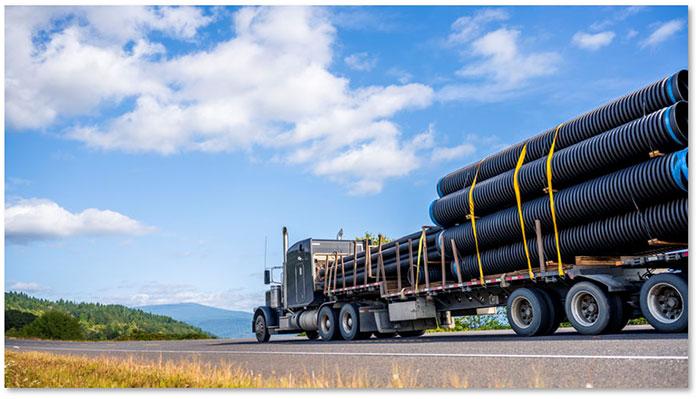Cargo securing means that the load must be securely fastened.This may seem obvious… Yet every year many deliveries are still damaged by shifting cargo.Not to mention the risk of accidents.This is not an empty term, but the basis for a whole series of rules (laid down in EUMOS legislation).However, there are several simple ways of ensuring that your cargo is secured.Here we look at the popular tools and summarise the main aspects of the legislation for you.
1. What cargo securing methods exist?
Il existe 2 façons de protéger votre cargaison contre le glissement ou le renversement : via une fermeture de force ou une fermeture de forme.
Une fermeture de force signifie que vous sécurisez votre charge en exerçant une force verticale vers le sol. Vous “poussez” la charge vers le bas, pour ainsi dire. Vous pouvez le faire en utilisant des sangles d’arrimage par exemple. Il est préférable de s’assurer que votre sol est propre. La saleté peut perturber le frottement. Pour augmenter la friction, vous pouvez utiliser des plaques antidérapantes.
Avec un fermeture de forme, votre cargaison est “enfermée”. Il n’y a donc pas (ou moins) de friction. Votre cargaison est en quelque sorte bloquée et n’a aucune marge de manœuvre. Vous pouvez y parvenir en chargeant votre camion de manière optimale et en remplissant les espaces vides avec des “coussins stabilisateurs”.
2. How do you secure your cargo?
| Pallets . 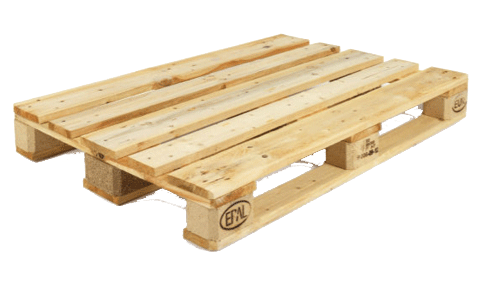 |
Pallets are absolutely essential for stable loading and safe transport. They are the first step in securing loads. Pallets – and especially wooden versions – offer greater friction with the ground, so your load will slide less. In addition, they always ensure that your load rests on a stable base. Would you like to know more? Then take a look at our guide to choosing pallets. |
| Stretch film . 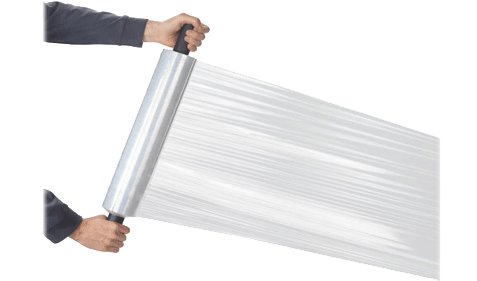 |
When stacked on a pallet, your bulk goods need to be securely tied together to form a homogeneous whole. Thanks to stretch film, your load will remain much more stable and will be less affected by shocks during transport. Another practical advantage is that the film protects your load against dirt, dust and rain. Want to know more? Then take a look at our guide to choosing stretch film. |
Strapping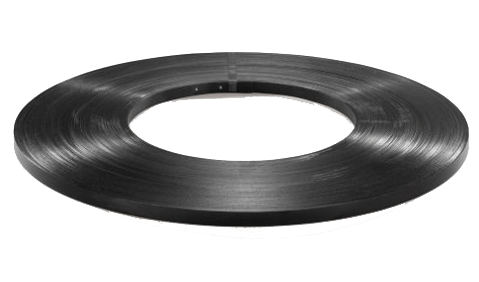 |
If your goods are too big or too heavy for stretch film, use strapping as an alternative. Steel versions in particular have a very high tensile strength. Simply wrap such steel strapping around your products and tighten it with a tensioner. This way, even your very heavy load will remain immobile. |
Lashing straps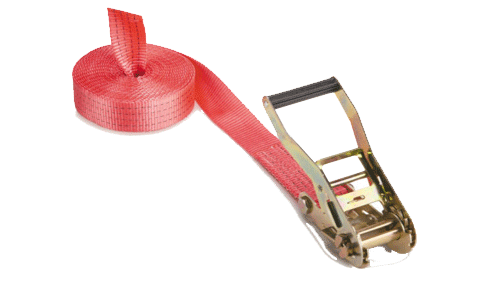 |
Tie-down straps are a common tool used to securely fasten a loaded pallet. This creates more force and friction against the ground, so your pallets are much less likely to shift. In addition to pallets, tie-down straps are also useful for securing bulky goods. |
Non-slip padding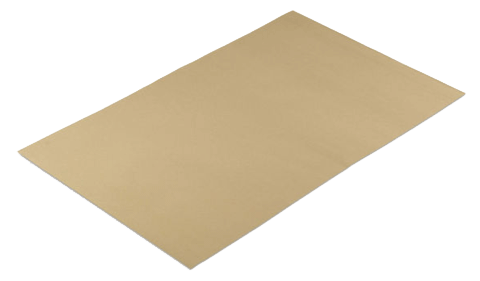 |
If your goods are stacked in layers on your pallet (e.g. stacked crates), then you should use an anti-slip pad between each layer. Even with a slight incline (up to 42°), your loads are much less likely to slip. |
Profiles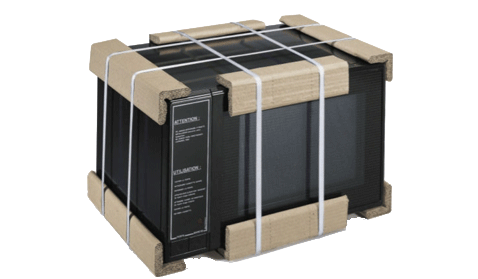 |
A cardboard profile can be placed on the corner of your pallet load. These profiles offer greater stability and protect your load from the force of a lashing strap. In addition, they ensure that the tension of a lashing strap is evenly distributed. |
Cylinder cushioning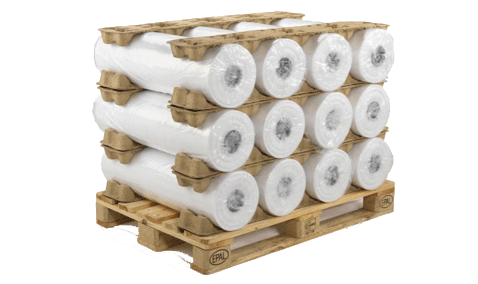 |
If you are transporting cylindrical objects, you should use suitable cushioning to prevent your products from rolling. Another advantage is that cylinder cushions are very light and can be nested, which reduces storage and shipping costs. |
Spacers and pads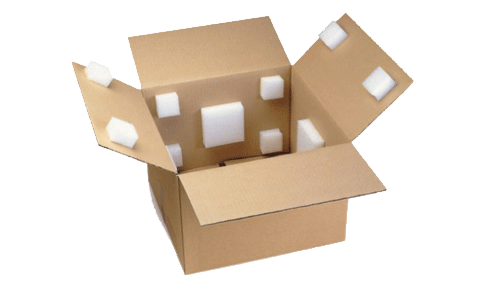 |
Foam spacers and pads are used on the inside of a crate to better hold bulk products. If your bulk products are more stable, there is less chance that your total load (e.g. a full pallet) will start to slip, so don’t forget the inside of your crates! |
Pallet collars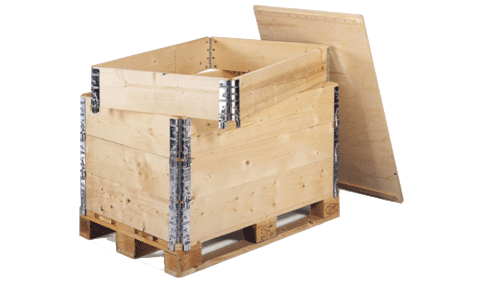 |
Pallet collarsare used for loading heavy or bulky goods. You place the collars on a pallet base and in no time at all you create homogeneous and stable boxes that you can transport much more safely. |
3. What does the EUMOS legislation mean for cargo securing?
has
been in force on all European roads since 2014.It sets out the strict rules for cargo securing in road transport.EUMOS legislation requires that your cargo is secured in such a way that it cannot fall off your vehicle under normal circumstances.Unexpected braking, sudden manoeuvring or poor road surfaces are some of these normal circumstances.
If your lorry is formally inspected during transport, the main thing that will be looked at is the way in which your cargo is secured.It is important that the cargo securing is able to withstand certain forces during transport.In normal traffic, the following forces occur
- In the direction of travel = 0.8 G = corresponds to 80% of the load weight,
- In the rear direction = 0.5 G = corresponds to 50% of the cargo weight,
- In the lateral direction = 0.5 G = corresponds to 50% of the weight of the load.
in other words, when your driver brakes hard, the cargo securing must absorb 80% of the weight of the load in the direction of travel and 50% in the sideways and rearward direction.
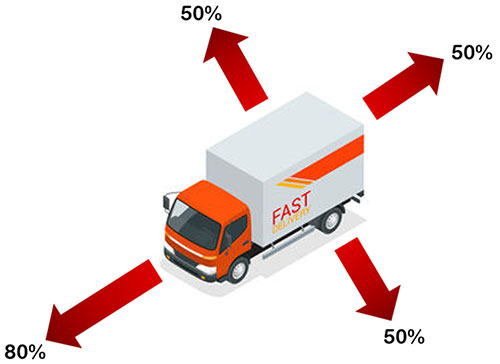
In addition, all the means you have used to reinforce your cargo must meet a number of conditions. These means must be in perfect condition and serve the purpose for which they are used. Tears, cuts, fraying or damage are therefore absolutely forbidden. In addition, they must comply with European and international product standards.
4. Who is responsible for an accident?
Since the introduction of the EUMOS legislation, several parties can be liable in case of an accident, not only the transport company. The liable parties can be divided into 5 categories.
| . 1. The driver |
The driver transporting the load in question must carry out a few checks before setting off. The driver can be held jointly and severally liable if these checks are not carried out. A driver must always
|
| . 2. The carrier |
It is the responsibility of the carrier to provide the appropriate documents to the competent authorities. Unless the carrier has made a special arrangement with another party. The carrier must
|
| . 3. The shipper |
The consignor shall ensure that the carrier receives the correct data so that he can transmit it to the control authorities. These data are
|
| . 4. The packer |
The packer should draw up a description of the goods. If, for example, the goods can be damaged by the lashing straps, the packer should describe an alternative method of securing these goods. Special requirements for the vehicle should be mentioned in the method. |
| . 5. The handler |
The handler ensures that the load is properly distributed in the truck. The handler ensures that the goods are loaded and secured. The handler ensures that the maximum permissible mass and axle loads are respected. In addition, the handler must provide the following information
|
